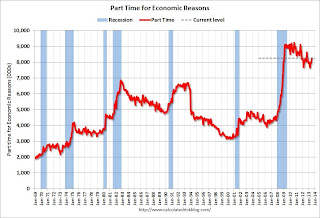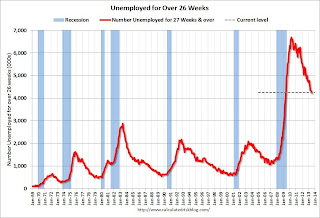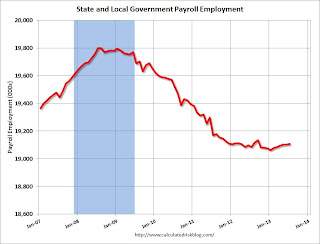by Calculated Risk on 8/02/2013 11:21:00 AM
Friday, August 02, 2013
Employment Report: Steady, but Slow Improvement
If we look at the year-over-year change in employment - to minimize the monthly volatility - total nonfarm employment is up 2.276 million from July 2012, and private employment is up 2.315 million. That is essentially the same year-over-year gain as in June (2.267 million total, 2.331 million private year-over-year in June). Steady, but not strong, job growth.
Hourly wages declined slightly in July, but are up 1.9% year-over-year. Hourly wages were up 2.1% year-over-year in June.
In July, average hourly earnings for all employees on private nonfarm payrolls edged down by 2 cents to $23.98, following a 10-cent increase in June. Over the year, average hourly earnings have risen by 44 cents, or 1.9 percent.The decline in the unemployment rate to 7.4% from 7.6% in June was due to a larger increase in employment in the household survey (227,000 increase in jobs) combined with a decline in the participation rate (not good news). If the participation rate had held steady, the unemployment rate would have declined to 7.5% instead of 7.4%.
In general this report was more of the same - steady but slow improvement.
A few more graphs ...
Employment-Population Ratio, 25 to 54 years old
 Click on graph for larger image.
Click on graph for larger image.Since the participation rate declined recently due to cyclical (recession) and demographic (aging population) reasons, an important graph is the employment-population ratio for the key working age group: 25 to 54 years old.
In the earlier period the employment-population ratio for this group was trending up as women joined the labor force. The ratio has been mostly moving sideways since the early '90s, with ups and downs related to the business cycle.
The ratio was unchanged at 75.9% in July. This ratio should probably move close to 80% as the economy recovers.
The participation rate for this group was also unchanged at 81.1% in July. The decline in the participation rate for this age group is probably mostly due to economic weakness (as opposed to demographics) and this suggests the labor market is still very weak.
Percent Job Losses During Recessions

This graph shows the job losses from the start of the employment recession, in percentage terms - this time aligned at maximum job losses. At the recent pace of improvement, it appears employment will be back to pre-recession levels next year (Of course this doesn't include population growth).
In the earlier post, the graph showed the job losses aligned at the start of the employment recession.
This financial crisis recession was much deeper than other post WWII recessions, and the recovery has been slower (the recovery from the 2001 recession was slow too). However, if we compare to other financial crisis recoveries, this recovery has actually been better than most.
Part Time for Economic Reasons
 From the BLS report:
From the BLS report:The number of persons employed part time for economic reasons (sometimes referred to as involuntary part-time workers) was essentially unchanged at 8.2 million in July. These individuals were working part time because their hours had been cut back or because they were unable to find a full-time job.The number of part time workers increased in July to 8.245 million.
These workers are included in the alternate measure of labor underutilization (U-6) that decreased to 14.0% in July from 14.3% in June.
Unemployed over 26 Weeks
 This graph shows the number of workers unemployed for 27 weeks or more.
This graph shows the number of workers unemployed for 27 weeks or more. According to the BLS, there are 4.246 million workers who have been unemployed for more than 26 weeks and still want a job. This was down from 4.328 million in June and is at the lowest level since May 2009. This is trending down, but is still very high. Long term unemployment remains one of the key labor problems in the US.
State and Local Government
 This graph shows total state and government payroll employment since January 2007. State and local governments lost jobs for four straight years. (Note: Scale doesn't start at zero to better show the change.)
This graph shows total state and government payroll employment since January 2007. State and local governments lost jobs for four straight years. (Note: Scale doesn't start at zero to better show the change.) In July 2013, state and local governments added 3,000 jobs, and state and local employment is up 31 thousand so far in 2013.
I think most of the state and local government layoffs are over. Of course Federal government layoffs are ongoing - and with many more layoffs expected.
Overall this was a tepid report - especially with the downward revisions to May and June employment and the slight decline in hourly wages. The labor market is still weak and millions of people are unemployed or underemployed.


